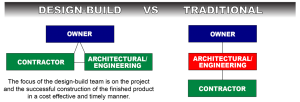Need to Rebuild or Repair after Damage?
Guest Post: The Design Build Process: Is it Right for Your Next Project?
Author: Adam Sherman
Residential home construction and remodeling has remained remarkably consistent through the years. For centuries, the primary method for designing and building construction projects was done by a single person. Often known as the “Master Builder,” this one person was responsible for taking care of the entire project from concept to completion.
The master builder method eventually gave way to the design-bid-build method where a client uses various independent professionals, including an architect and general contractor, for each phase of a project.
Today, as the design-build method has gained in popularity, the home remodeling process has come full circle. Design-build resembles the master builder method in that one single entity (but not one single person) assumes organizational and managerial control of a project. This approach allows for a more seamless union of design and construction.
What Sets the Design-Build Process Apart?
A design-build firm provides all the services of a general contractor but is also fully involved in the design aspects of a project.
1. General contractors typically have experience in all areas of residential construction and oversee all functional aspects of the construction process. They do not, however, get involved in the design side. They also are not involved in helping a client select the specific materials used for their project.
2. A design-build firm provides the technical expertise of a general contractor, but also provides direct input into things like layout and choosing finishes. For example, general contractors typically measure for and install kitchen cabinets. A design build firm works with the client from the start, helping them make a cabinet choice that complements the final function and visual appeal of the finished space. Careful attention is paid to the client’s preferences and suggestions are made that are best suited to the client’ situation, needs, and budget.

How Clients Benefit
From a small powder room makeover to a complete home renovation, all remodels can benefit from the design-build process. It doesn’t take long for homeowners to appreciate the convenience of having a single point of contact for all aspects of the project.
One of the greatest benefits of the design-build method? How it moves the “moment of truth,” i.e. “how much will this cost me?” from the middle of the process to the beginning. No one places an order, lifts a hammer, or spends serious money until every design detail has been worked out.
The focus of a design-build firm is to anticipate problems before they happen while designing your vision within a set budget. A single source of accountability, budget management, and enhanced communication all come together to create an enjoyable remodeling experience.
Look for a Contractor With a Process
If you think the design-build approach is the right one for you, look for a firm that has a solid process that ensures your satisfaction. Our firm, based in Philadelphia, has well-defined procedures for each phase of the design-build process.
1. An in-home consultation covers your priorities and goals, as well as your budget considerations.
2. A written design proposal sets out your goals. In it, we discuss the design steps our firm will follow, ballpark costing and a fixed cost for the design work.
3. The design phase can include a designer, an interior space planner, an architect, or an engineer. We work to narrow the overall scope of your project to determine the best design direction that will produce a plan that’s ready for cost estimating.
4. A construction proposal offers an itemized breakdown of costs, including labor and materials, options, allowances, and a preliminary construction schedule with payment plan.
5. You’re introduced to your project manager at the pre-construction meeting where you discuss things like communication, dust protection, access to the open, schedule details, and a variety of other important job aspects.
6. The construction phase begins once the permits are in place. Demolition is followed by foundation and framing. Plumbing, electrical, and HVAC followed by insulation, sheetrock or plaster. Trim, cabinets, and other finishes are installed.
7. A punch list is compiled, and a completion schedule is decided on.
All successful design-build remodeling projects start with mutual trust and respect for the client-contractor relationship. When a dedicated team works with you to design and accomplish every aspect of your home remodeling project, it makes it easier to establish such a mutually beneficial rapport.
While the design-build concept may be old, it’s one of the fastest growing trends in today’s home improvement world. Properly coordinated and executed, this new, old-fashioned method can save you time and money while ensuring a stress-free experience on your next remodeling project.
Adam Sherman is the owner of Cottage Industries, a design-build firm serving Philadelphia and the Main Line.
